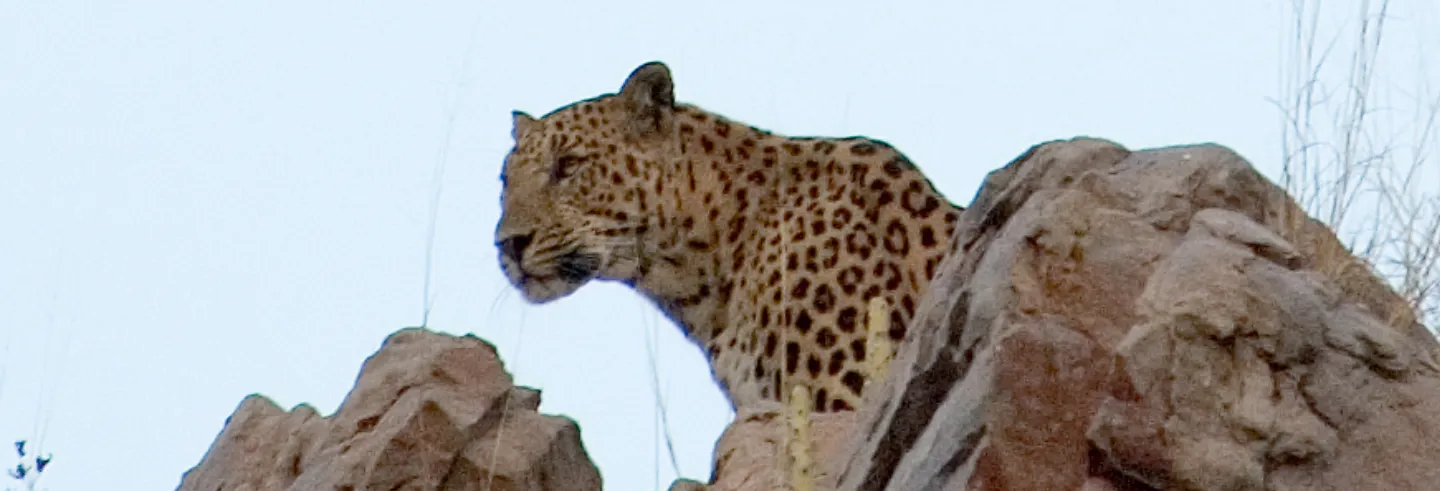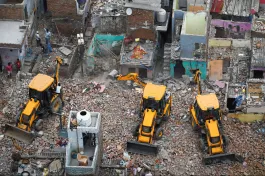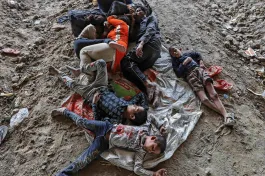In April of 2015 I was informed by some colleagues that a leopard had mauled a child in a tiny, impoverished village by the edge of a wildlife sanctuary in eastern Uttar Pradesh. The aftermath of such events is invariably marked by an outpouring of rage, occasionally leading to violence. As I was in the area, on a pre-dissertation survey to identify potential field sites, I was requested by a colleague to travel to the village to report on the mitigatory and compensatory measures undertaken by the forest department and the WWF, the international conservation organisation.
Three hours after receiving the call, I arrived at the location. A most extraordinary farce was playing out to the shrill chorus of awakening crickets and birds heading home to roost. A posse of exasperated wildlife guards were gathered along the forest edge, straight across from the village the mauled boy hailed from. In between the village and the forest was a narrow weed ridden wetland where, earlier that day, the boy and his friend had encountered the leopard. At the edge of the wetland sat a large metal cage housing a scrawny and unhappy goat. Many yards beyond the cage, a group of men form the village sat under a tree chatting animatedly.
The forest guards told me that the whole incident was being blown out of proportion. In their version of events, it was the boy’s fault that he was mauled: he had attempted to ‘tease’ the leopard and had suffered the inevitable consequence of this rash decision. The villagers on the other hand contended that the leopard was the original aggressor. The truth perhaps as usual lay somewhere in the middle.
To appease the angry villagers, the forest department had decided that they would at least pretend to try trapping the leopard. Hence the barely concealed cage and the bait purchased from the villagers themselves for a sum of Rs 500.
That night the forest guards and the villagers played the game of ‘we know that they know that we know that they know’.
It was clear to anyone who had at least trapped a rat in their homes that trapping an animal – especially one as wary as a leopard – required more chicanery than what was on display. I told the guards that as far as pretences went, they were doing a rather poor job. To this, a guard told me something that gave me a full measure of my naivete. He said that the moment they left the spot, the villagers would untie and take away their goat and later force the forest department to buy it back from them a second time!
Through the rest of that night the forest guards and the villagers played the game of ‘we know that they know that we know that they know’. The next morning, after having run through the pretence, the goat was untied, and the cage stowed away.
But the villagers’ anger had, understandably, not been assuaged. A new tactic had to be devised.
The gathered officials thought that after the previous evening’s testosterone high, that a woman’s touch might be the salve that the situation needed. They suggested that I walk over to the other side and speak with the women of the village and try to “explain the matter” to them. There I was – a city-slicker from Mumbai, a PhD candidate in ecology at a US university – being asked to mediate a fraught situation involving leopards, and people from a tiny hamlet.
But at that moment, for the hatchers of this scheme, the entire complexity of the world could be neatly parsed along two lines: one that neatly divided the genders and the other, the equally insidious one, that divided the world into those who could and could not legitimately make a living off the forest.
The forest fulfilled every desperate need for now, even as living by the forest had left most of their wants unfulfilled.
Curious to learn more about what life is like living on the edges of a protected area, I walked over to the other side to meet the women from the village who were now assembled in a shed meant for gramsabha meetings. After I apologised for my limited language fluency, we began talking. Our ensuing conversation had little on leopards or tigers and almost everything to do with lighting, toilets, and doors.
The villagers, mostly marginal farmers and herders made a living by engaging in petty trade and in manual labour, often for the sanctuary. As was common in that part of the country, most homes – thatch and mud structures – lacked a door. Wood scrounged from the forest, often by evading the forest staff was needed for cooking and a wood door was an impossible luxury. Despite years of promises, there was no lighting in the village, and there were no toilets. The forest fulfilled every desperate need for now, even as living by the forest had left most of their wants unfulfilled.
After a few hours, I asked how the boy was doing and if he had received adequate medical care the previous day. The women said that I should take a look for myself. We walked over to the boy’s house. A wiry boy of about eight accompanied by his mother emerged from the little mud hut. He had a small puncture wound on his cheek and a deeper one on his left shoulder. The wound appeared clean, and the boy seemed like he was recovering well. The nature of the injuries seemed to suggest that the whole episode might have indeed been on account of an accidental encounter.
The sight of the boy and his injuries, however, refreshed the crowd’s memory of the attack. It restarted a hubbub amongst the women to catch and relocate the leopard. I began to get a little nervous watching the growing fervour and wondered what promises they would extract from me.
At that moment, I felt the world shaking.
Thinking that I was getting dizzy from dehydration, I reached out for the wall of the boy’s house to steady myself. But the little mud hut shook violently. One of the women reached out for my arm. We collectively registered the reality of a violent earthquake.
The great Himalayan range had lurched forward and dropped a metre, wreaking havoc in its wake.
Some distance away, a group of men threw their gamchchas (scarves) in the air and yelled out the name of a god and then squatted on the floor. We followed their lead and squatted. After what felt like many seconds, the shaking stopped. I stared at the women in disbelief while they took in the sights of their homes miraculously still standing.
To our northeast, unknown to us, the great Himalayan range had lurched forward and dropped a metre, wreaking havoc in its wake. Kathmandu lay in shambles.
All we were aware of was that a silent force had asserted herself, to remind us of the illusory stabilities upon which we ground our hopes and dreams. In that moment of shared vulnerability, we forgot the events that had led us up to that point. For a second, we were earthlings. For ten more, we were equal citizens of an iniquitous republic. The women enquired about my family, where I was from, and insisted that I eat lunch with them. I told them a little about my world and in turn insisted that I must take their leave. As I retraced my steps back to the forest edge, the women bid me goodbye and said that they knew that I could not help them, but at the very least I could share their story.
We parted ways and I ventured forth towards my horizons. . Behind me, the women returned to their doorless homes, upon which time sat recalcitrant and heavy. Somewhere, outside of time, in the liminal spaces of that cleaved landscape, the children continued to play and the leopard returned to live another day.
(Disclosure: This event transpired while I was on a reconnaissance survey ahead of my dissertation fieldwork which was partially funded by WWF-India. The family in question received immediate compensation and their medical expenses were covered by the forest department and WWF.)
Rekha Warrier, a postdoctoral fellow at Colorado State University, is an ecologist who works on human-wildlife coexistence questions.









